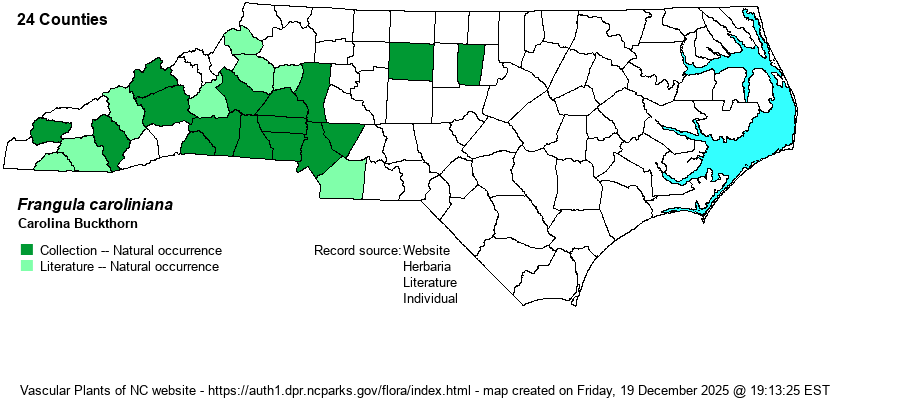| Author | (Walter) A. Gray | |
| Distribution | Primarily in the southwestern third of the Piedmont, ranging essentially north to Burke and Iredell counties, and east to Cabarrus and Union counties. Strongly disjunct records east to Guilford and Orange counties, if naturally occurring there. It also is present sparingly in the southern Mountains, mainly at low elevations, north to Madison and (reportedly) Watauga counties.
This is a Mid-South species with its range centered mainly west of NC. It ranges from southwestern VA and central FL west to central TX and MO, mainly avoiding the Atlantic Coastal Plain.
| |
| Abundance | Uncommon in the southwestern Piedmont, and rare in the lower Mountains. Can be somewhat widespread in a few counties that contain considerable amounts of circumneutral or basic soils. The NCNHP considers this as a Watch List species. | |
| Habitat | This species favors rich, circumneutral forests, such as Basic Mesic Forest and to a lesser extent Basic Oak-Hickory Forest types. It is not normally found in bottomlands or other wetlands, favoring slopes and various other uplands. |
| Phenology | Flowers in May and June, and fruits in September and October. Though the flowers are small and insignificant, the fruits – bright red “berries” (drupes) when not mature but black when ripe – attract attention. | |
| Identification | This is a small tree, or less often a large shrub, that grows with a single trunk (usually) to an average height of 20-30 feet. It has deciduous, alternate leaves that have a distinctive look; they are narrowly elliptic to almost oblong, growing to about 4 inches long but only about 1-1.5 inches wide. In addition, the leaves feature strongly diagonal, parallel leaf veins, with about 8-10 pairs of veins. The general leaf shape, and the numerous “berries”, red at first and then turning black, can fool an observer into thinking the tree is a Black Cherry (Prunus serotina). However, the strongly parallel leaf veins, the hairy and naked end buds, the berries along the branches and not in a terminal cluster, and a lack of a stinking odor when a twig is broken will lead one away from the cherry to this uncommon species. | |
| Taxonomic Comments | This tree was well known as Rhamnus caroliniana through much of the last century. However, it has since been moved to the genus Frangula.
| |
| Other Common Name(s) | None in much usage | |
| State Rank | S3 | |
| Global Rank | G5 | |
| State Status | W1 | |
| US Status | | |
| USACE-agcp | FACU link |
| USACE-emp | FAC link |

